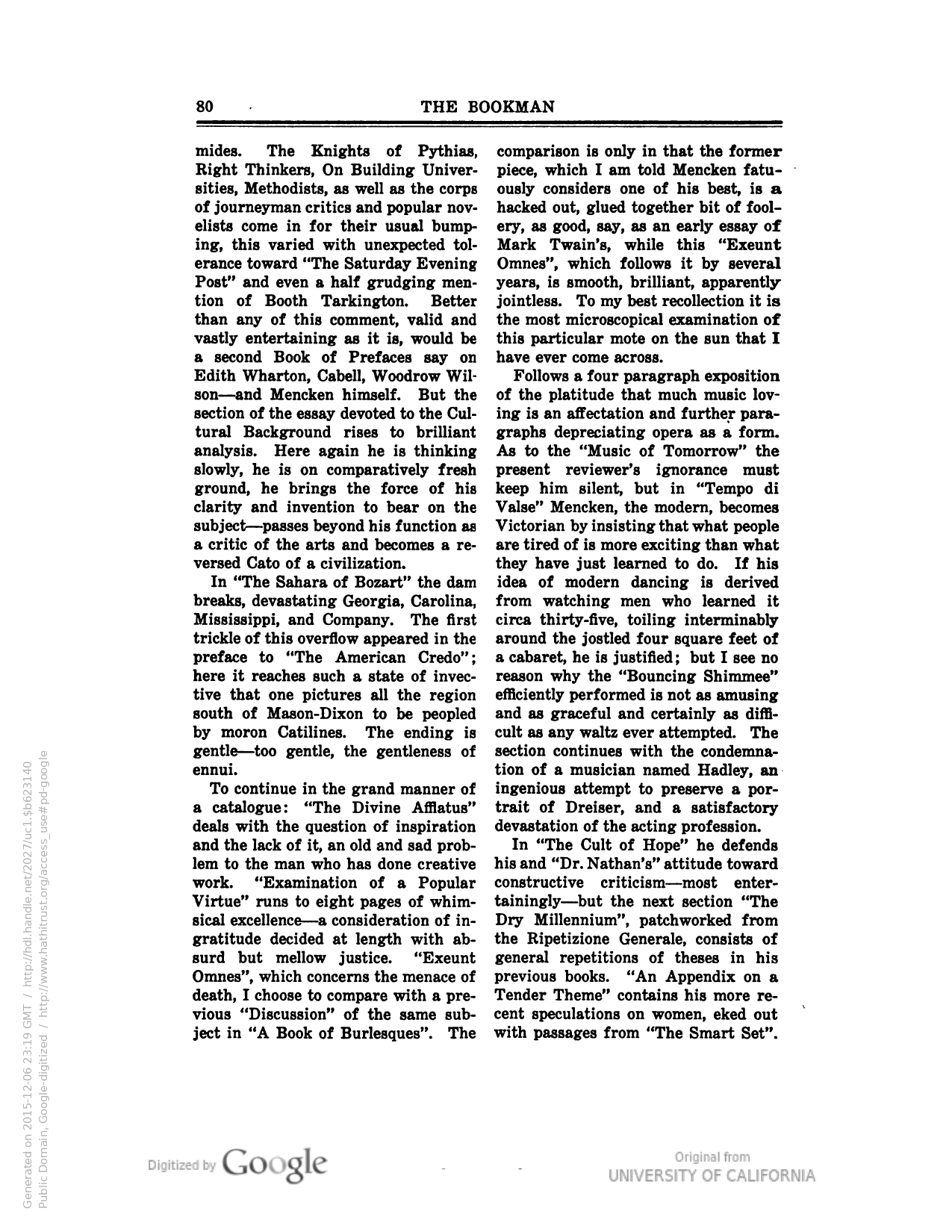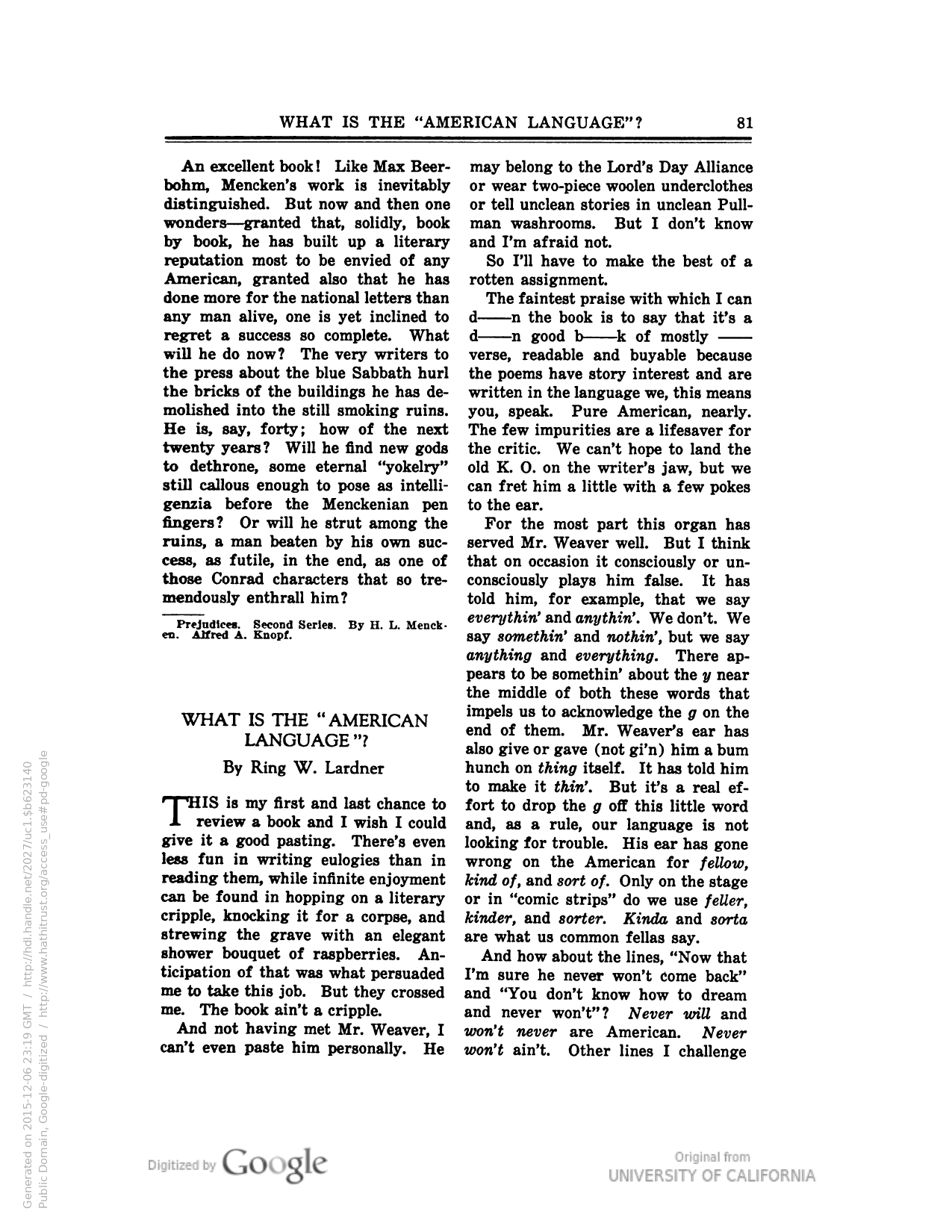
The Baltimore Anti-Christ
by F. Scott Fitzgerald
The incomparable Mencken will, I fear, meet the fate of Aristides.1 He will be exiled because one is tired of hearing his praises sung. In at least three contemporary novels he is mentioned as though he were dead as Voltaire2 and as secure as Shaw with what he would term “a polite bow.” His style is imitated by four-fifths of the younger critics; moreover, he has demolished his enemies and set up his own gods in the literary supplements.
Of the essays in the new book the best is the autopsy on the still damp bones of Roosevelt.3 In the hands of Mencken Roosevelt becomes almost a figure of Greek tragedy; more, he becomes alive and loses some of that stuffiness that of late has become attached to all 100% Americans. Not only is the essay most illuminating but its style is a return to Mencken’s best manner, the style of Prefaces4 with the soft pedal on his amazing chord of adjectives and a tendency to invent new similes instead of refurbishing his amusing but somewhat overworked old ones.
Except for the section on American aristocracy there is little new in the first essay “The National Letters”: an abundance of wit and a dozen ideas that within the past year and under his own deft hand have become bromides. The Knights of Pythias,5 Right Thinkers, On Building Universities, Methodists, as well as the corps of journeyman critics and popular novelists come in for their usual bumping, this varied with unexpected tolerance toward The Saturday Evening Post and even a half grudging mention of Booth Tarkington. Better than any of this comment, valid and vastly entertaining as it is, would be a second Book of Prefaces say on Edith Wharton, Cabell, Woodrow Wilson6—and Mencken himself. But the section of the essay devoted to the Cultural Background rises to brilliant analysis. Here again he is thinking slowly, he is on comparatively fresh ground, he brings the force of his clarity and invention to bear on the subject—passes beyond his function as a critic of the arts and becomes a reversed Cato7 of a civilization.
In “The Sahara of Bozart”8 the dam breaks, devastating Georgia, Carolina, Mississippi, and Company. The first trickle of this overflow appeared in the preface to The American Credo;9 here it reaches such a state of invective that one pictures all the region south of Mason-Dixon to be peopled by moron Catilines.10 The ending is gentle—too gentle, the gentleness of ennui.
To continue in the grand manner of a catalogue: “The Divine Afflatus” deals with the question of inspiration and the lack of it, an old and sad problem to the man who has done creative work. “Examination of a Popular Virtue” runs to eight pages of whimsical excellence—a consideration of ingratitude decided at length with absurd but mellow justice. “Exeunt Omnes,” which concerns the menace of death, I choose to compare with a previous “Discussion” of the same subject in A Book of Burlesques.11 The comparison is only in that the former piece, which I am told Mencken fatuously considers one of his best, is a hacked out, glued together bit of foolery, as good, say, as an early essay of Mark Twain’s, while this “Exeunt Omnes,” which follows it by several years, is smooth, brilliant, apparently jointless. To my best recollection it is the most microscopical examination of this particular mote on the sun that I have ever come across.
Follows a four paragraph exposition of the platitude that much music loving is an affectation and further paragraphs depreciating opera as a form. As to the “Music of Tomorrow” the present reviewer’s ignorance must keep him silent, but in “Tempo di Valse” Mencken, the modern, becomes Victorian by insisting that what people are tired of is more exciting than what they have just learned to do. If his idea of modern dancing is derived from watching men who learned it circa thirty-five, toiling interminably around the jostled four square feet of a cabaret, he is justified; but I see no reason why the “Bouncing Shimmee” efficiently performed is not as amusing and as graceful and certainly as difficult as any waltz ever attempted. The section continues with the condemnation of a musician named Hadley,12 an ingenious attempt to preserve a portrait of Dreiser, and a satisfactory devastation of the acting profession.
In “The Cult of Hope” he defends his and “Dr. Nathan’s”13 attitude toward constructive criticism—most entertainingly—but the next section “The Dry Millennium,” patchworked from the Repetition Generale,14 consists of general repetitions of theses in his previous books. “An Appendix on a Tender Theme” contains his more recent speculations on women, eked out with passages from The Smart Set.
An excellent book! Like Max Beerbohm,15 Mencken’s work is inevitably distinguished. But now and then one wonders—granted that, solidly, book by book, he has built up a literary reputation most to be envied of any American, granted also that he has done more for the national letters than any man alive— one is yet inclined to regret a success so complete. What will he do now? The very writers to the press about the blue sabbath16 hurl the bricks of the buildings he has demolished into the still smoking ruins. He is, say, forty; how of the next twenty years? Will he find new gods to dethrone, some eternal “yokelry” still callous enough to pose as intelligentsia before the Menckenian pen fingers? Or will he strut among the ruins, a man beaten by his own success, as futile, in the end, as one of those Conrad characters that so tremendously enthrall him?
Prejudices, Second Series. By H. L. Mencken.
Notes
1. Greek general (550-468 B.C.), who was known as “The Just.”
2. Francois Marie Arouet de Voltaire (1694-1778), French author best known for his philosophical tale, Candide (1759).
3. Theodore Roosevelt (1858-1919), twenty-sixth president of the United States.
4. A Book of Prefaces (1917).
5. Fraternal organization.
6. (1856-1924), twenty-eighth president of the United States.
7. Dionysias Cato—name assigned to a fourth-century volume of Latin precepts; its author is unknown.
8. One of Mencken’s most celebrated essays; its title refers to the American South— i.e., the Sahara of the Beaux Arts.
9. 1920 volume by Mencken and George Jean Nathan (1882-1958); it is subtitled A Contribution toward the Interpretation of the National Mind.
10. Catiline (108-62 B.C.) was a Roman conspirator.
11. 1916, revised 1920; volume by Mencken.
12. Henry K. Hadley (1871-1937), composer of “In Bohemia: A Concert Overture for Full Orchestra” (1912).
13. Mencken and Nathan applied honorifics to each other.
14. A department in The Smart Set, a magazine edited by Mencken and Nathan.
15. (1872-1956), English parodist.
16. So-called blue laws banned public entertainments on Sunday.
Published in The Bookman magazine (March 1921); see also on the adjacent pages Ring Lardner's review of In American by J. V. A. Weawer.
Not illustrated.




